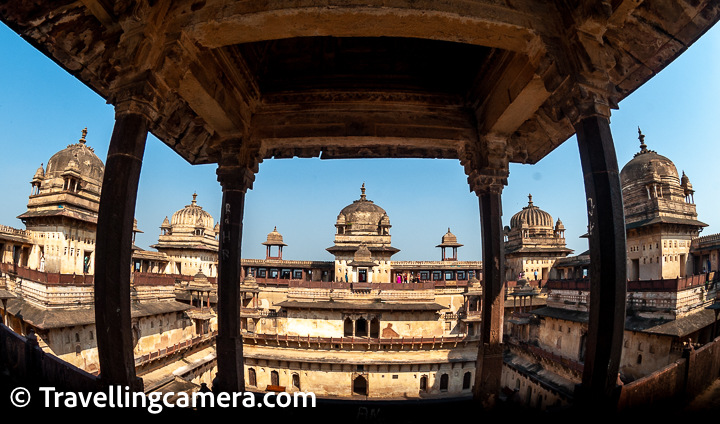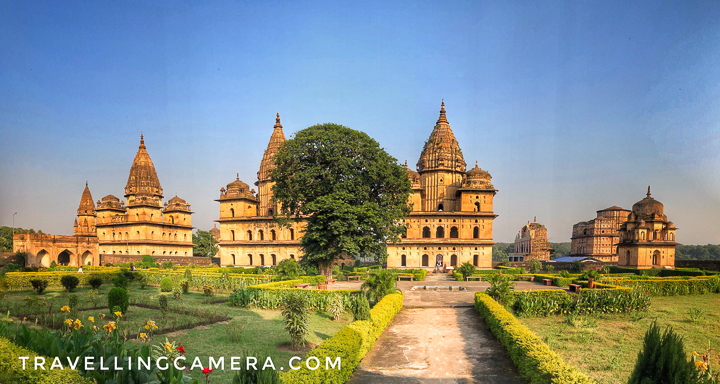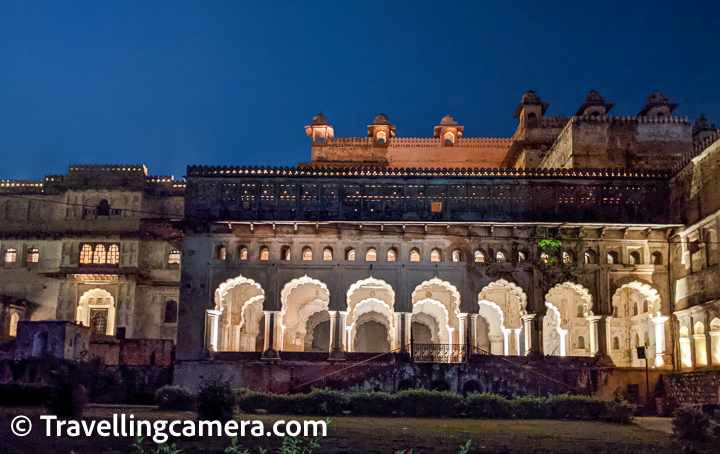
When we start planning a trip and after we come back, there are certain learnings which can help community plan better. Certainly, same solution or thought process doesn't work for everyone and all of us have different definition and priorities when we say we travel to explore. Having said that, today I am making a statement that Orchha can be explored in a day. That doesn't mean that you can't spend more time around this beautiful heritage town of Madhya Pradesh, but what I mean to say is that if you have only one day in hand, you can very well plan for it and explore well. This blogpost will help you with a clear plan to ensure that we save your time in terms of doing to & fro or finding parking, grabbing tickets etc. Let's check out what plan do I have for you.
Before we dive into exact plan for the day, let me share some key pointers for you to keep in mind :
1. Tickets for all monuments can only be bought of Orchha Palace.
2. If you are in a car, buy 30 rs parking ticket at one place and it works in whole town. Please remember it's one time for a day. There is a scam around it to make tourists fool and charge parking fees every time at every tourist spot.
3. Orchha is a small town and most of the tourist attractions are nearby. One can also walk easily between these key points of attraction in Orchha town.
Let's start with one dat itinerary to explore Orchha well:
1. Orchha Palace, Sheesh Mahal and Raja Mahal :

First you should go to the Orchha palace. As you cross the bridge and the first entry gate you’ll see counter on the left. This is the place to get tickets for all monuments of Orchha. It’s not that you have to buy multiple tickets but single ticket for the day works at all monuments of Orchha. So remember to keep the ticket safe with you.
Indian Citizens: 10 INR
Camera: 25 INR per camera
Video camera: 200 INR per camera

If you are driving, keep driving on the road which takes you to the palace. There is more than enough parking space in front of the police entry. This parking lot is just in front of Sheeshmahal, which is a luxury hotel run by Madhya Pradesh tourism.

When compared to some of the other forts of India, the
Orchha fort seems in a fairly good shape. It is built of red and yellow sandstone and has weathered well. The carvings are still intact and the murals, though faded, can still be made out. If you look out from the latticed windows of the Jahangir Mahal, you can take in the lush green plans that surround the Palace complex and also at the smaller monuments that dot the landscape.
Like many forts, the Orchha fort also houses several monuments within its boundaries, including the ones that are across the bridge that connects the Orchha Palace with Orchha town. But in this post, we will talk about the monuments within the Orchha Palace complex. The oldest among these is the Raja Mahal, which was built in the early 16th century.
The construction was started by the Bundela King Rudra Pratap Singh right after he founded Orchha. However, the King never really got to enjoy the fruit of his labour. By the time the construction completed (which did not take too long - a couple of years at max), the King had died and his descendent Bharti Chand, who ruled from 1531 to 1554 added some finishing touches to the palace.

When you are done with Orchha palace, you may also want to go to Raja Mahal which is just in front of the main palace. This is also the place where evening light and show happens.
The Raja Mahal appears to be a very simple and unimposing structure from outside (more so since there are other palaces within the complex that are much more imposing and opulent). However, when you go inside, you find the remains of intricate artwork and grand murals on the ceilings and walls. The Mahal is rumored to have several hidden passages and narrow stairways to higher floors. All very interesting to explore.
The Mahal also has a pillared structure, known as "Diwan-e-aam", where the Raja would meet the aam junta and resolve disputes etc. When we got here, we found the place overrun by a band of langoors and it looked pretty dangerous to explore. So we avoided it altogether. Then there was also the "Diwan-e-khas" where the Raja would meet his close confidantes.
After King Bharti Chand, his younger brother Madhukar Shah took over and added a few embellishments to the Palace. However, one of the most important addition to the Palace complex was done by Raja Bir Singh Deo (Madhukar Shah's son). Bir Singh Deo was a close friend of Emperor Jahangir, having helped assassinate Abul Fazl, one of the navratns of Badshah Akbar, who was also one of the only obstacles in Shehzada Salim (later Jahangir) ascending the throne after his father.
This friendship between Bir Singh Deo and Emperor Jahangir proved to be very beneficial for Orchha. So when Emperor Jahangir was scheduled to visit Orchha, Bir Singh Deo ordered a new palace to be built for the emperor. This palace would sit higher than any other monument in Orchha and would be known as Jahangir Palace. The palace was built in the early 17th century.

After that you can take your car And go towards popular Chhattris of Orchha. Now you need to Buy parking ticket which costs Rs.30. As I mentioned earlier this parking ticket works everywhere in Orchha. Just show the ticket to the guard at entry gate of Chatri’s. Spend some time appreciating beautiful architecture and the well-maintained park with green landscapes and colorful photographs. There’s a little pond in the middle of this compound with a shiv ling in the center. Depending upon the lighting conditions you may get some very good photographs of Chattris in water reflection.
Chhatris are a common feature in
Rajasthan and
Madhya Pradesh, and some can also be found on the outskirts of Bhuj, dedicated to some of the Jadeja Rules. Chhatri's are features of Indo-Islamic
architecture. Outside India, a couple of Chhatris can also be found in the United Kingdom. One such Chhatri is in Brighton, dedicated to the Indian Soldiers who died in the First World War. And the other is near Bristol, to commemorate Raja Ram Mohan Roy, who died in this city.
The Chhatris in
Orchha are quite beautiful and the fact that the lawns around them are very well maintained, adds to their grace. The lawns are also home to several species of birds. I spent considerable time searching for a particularly noisy parrot and then ultimately spotting a little owlet instead.
There are about 15 Chhatris in Orchha, dedicated to generations of Bundela Kings who have ruled Orchha since the early 16th century, such as Raja Vir Singh Deo, Jashwant Singh, Sujan Singh, Bharti Chandra, Indramani, etc. Some of the them, like the one dedicated to Raja Vir Singh Deo, the King whose reign is said to be the golden era of Orchha, are located right on the banks of Betwa river on Kanchana Ghat.

As you come out from Chattris, you can walk to the ghat in front of Betwa River. This is a good place to sit down and enjoy the ambience of the place. Just across this ghat there is Sunset point. Depending upon time availability we would recommend That you go to the wildlife park to see sunset behind Orchha chhattris.
There is a road which connects directly with Laxmi Narayan temple. So you don’t need to go back to the town for reaching this temple. This road goes through Kalpvriksha tree.
The Laxmi Temple (or Laxmi Narayan temple) in Orchha, Madhya Pradesh, is an interesting specimen of Bundela Architecture. Unlike the Raja Ram temple and Chaturbhuj temple, the Laxmi temple isn't close to the Orchha Fort. It is about 2km away from the main Fort complex and is built on a small hillock.
There’s no dedicated parking lot near Laxmi Narayan temple. So when you reach there find an appropriate space on the side of the road to park your car. They found it pretty safe so don’t need to worry about it. There’s little climb for the temple.
Though you can easily walk to the temple, it is also approachable by car and you can reach right up to the entrance of the temple on your vehicle. So elderly people too can easily visit the temple. And most of the murals and frescos are on the ground level.
The temple combines two styles of architecture - those of a temple and a fort. It is a rectangular structure with high walls and fort-like bastions on all corners, as if it is ready for canons and guns to be deployed in case of war. The temple is built with lime mortar and bricks.
The walls in the temple are covered with colorful frescos that still retain their original vibrancy and beauty. One can spend hours admiring these frescos because you can easily see the passage of time in them. While there are frescos dedicated Gods and to Bundela kings and their consorts, you also find a depiction of the Mughal rulers and the East India company.

After exploring Laxmi Narayan temple you can go back to the town and find common parking lot where your existing parking ticket will work. Park your car and if you want to eat something there are a few cafés around this place. And then you can walk to the Chaturbhuj Temple which gives great views of Orchha palace.
The Chaturbhuj Temple is one of the most noticeable element of Orchha Skyline of Madhya Pradesh. Its Vimana stands tall and can be viewed from miles away. In a way, it is like the centerpiece around which the Orchha town has grown. When you think of a temple like this, you expect it to be as opulent inside as its exteriors are. But that is one of the interesting aspects of this temple. Its insides are stark and bare with one idol at the extreme end of it. Once you are inside, it is easy to forget how imposing it is when viewed from a distance.
The temple is a few meters away from the Raja Ram temple and was supposed to be the Abode of the Raja Ram's idol, which is currently placed at the Raja Ram temple. Apparently the idol refused to be moved from its place from the original Rani Mahal. This Mahal was then renamed Raja Ram Temple and Chaturbhuj temple became a temple dedicated to the four-armed avatar of Lord Vishnu "Chaturbhuj".
The temple currently has an idol of Radha Krishna in its garbha. One can climb a narrow and steep flight of stairs to reach the terrace of the temple from where one can apparently see spectacular views of Orchha town. However, we had to skip this adventure because we reached late and the terrace had already closed for the day.
Since we did not get to the terrace of the temple, we cannot comment about that, but otherwise, the visit to the temple takes at most half an hour if it is not crowded. And there's also an overall relaxed feel to this place.

Now depending upon the time you can decide what do you want to do. Usually either you can See the sunset behind Chhattris or go for the light and sound show. If you choose light and sound show which we recommend, you need to buy another ticket for it. The light and sound show happens in Hindi as well as English.
Light show ticket: Indian Adult: 200 INR
The show is available both in Hindi and in English. While we were there, the timing of the show was 7:30 to 8:30 pm in Hindi and 8:30 to 9:30 pm in English. We chose the English show because we were hungry and wanted to have hot food before going to watch the 1 hour long show in open. Even though this was Madhya Pradesh and not really winter yet, it was cold-ish in the evenings.
The show is organized opposite the Diwan-e-aam and lighting and sound equipments are arranged at strategic locations on Sheesh Mahal, Diwan-e-aam, and the lawn, and the stories are those of valor of the Bundela Kings and their righteousness. So in that sense, it is a one-sided narrative, but that is how most of the light and sound shows are.
The story starts with how Orchha was founded and that of course brings into picture the Bundela King Rudra Pratap Singh, who started the construction of Orchha Fort, right after founding Orchha. However, the King never really got to enjoy the fruit of his labour. By the time the construction completed (which did not take too long - a couple of years at max), the King had died and his descendent Bharti Chand, who ruled from 1531 to 1554 added some finishing touches to the palace.
Another major story that led to the addition of the biggest and most impressive and imposing structure in the fort complex is that of Raja Bir Singh Deo's friendship with Shehenshah Jahangir after Bir Singh Deo helped assassinate Abul Fazl, one of the navratns of Badshah Akbar, who was also one of the only obstacles in Shehzada Salim (later Jahangir) ascending the throne after his father.
6. Aarti at Raja Ram Temple :

After light and sound show you can walk to the Rajaram temple and witness evening Aarati.
The Raja Ram Temple in Orchha, Madhya Pradesh, is the only temple in the world where Lord Ram is worshipped as a King. The temple was originally the Rani Mahal and was converted into a temple for Raja Ram when an idol brought here from Ayodhaya refused to be moved to the temple that was built for it.
Here's how the legend goes - the 16th century was also the period when the temples of North India were seeing widespread destruction at the hands of invaders. Historical texts from various sources claim that temples were also destroyed at Ayodhya during this period. Meanwhile as per the legends, almost 500 kms away, in the city of Orchha, a tussle erupted between the erstwhile King Madhukar Shah Ju Dev and his wife Queen Ganeshkunwari. The King was a devotee of Lord Krishna and the Queen, of Lord Ram.
The dispute apparently was about a religious travel. While the king wanted to go to Vrindavan, the queen wanted to go to Ayodhya. The argument resulted in the queen being banished from the Kingdom with a diktat that she will only be allowed re-entry if she is able to bring back Lord Ram from Ayodhya. The Queen went to Ayodhya and did tough sadhana for 21 days. However, when Lord Ram did not appear even after that, she jumped into the river Sarayu. From where she emerged with Lord Ram as a child in her lap.
When the Queen requested Lord Ram to accompany her to Orchha, the Lord agreed on some conditions. She was to travel to Orchha on foot, walking only on Pukh Nakshatra, and he would take a permanent seat at the place where he is set down first, and after he takes a seat at Orchha, he will be the King and there will be no other Kings at Orchha after this. The queen agreed to all these conditions and started her journey back to Orchha. In the meanwhile, the King in Orchha had a dream where Lord Krishna reprimanded him for differentiating between Lord Ram and Lord Krishna.
The aarti for Raja Ram takes place 4 times in the day and a guard of honour is held every day. Raja Ram also has his own security in form of designated police personnel.
History and mythology at times can be used to complement each other, to fill in the gaps, and to make the story complete. Both the mediums are prone to error, and both the mediums have their own set of faithful audience. No city demonstrates this better than the City of Orchha in Madhya Pradesh, a place of mysteries and whose name itself means "Hidden".
















.jpg)
Comments